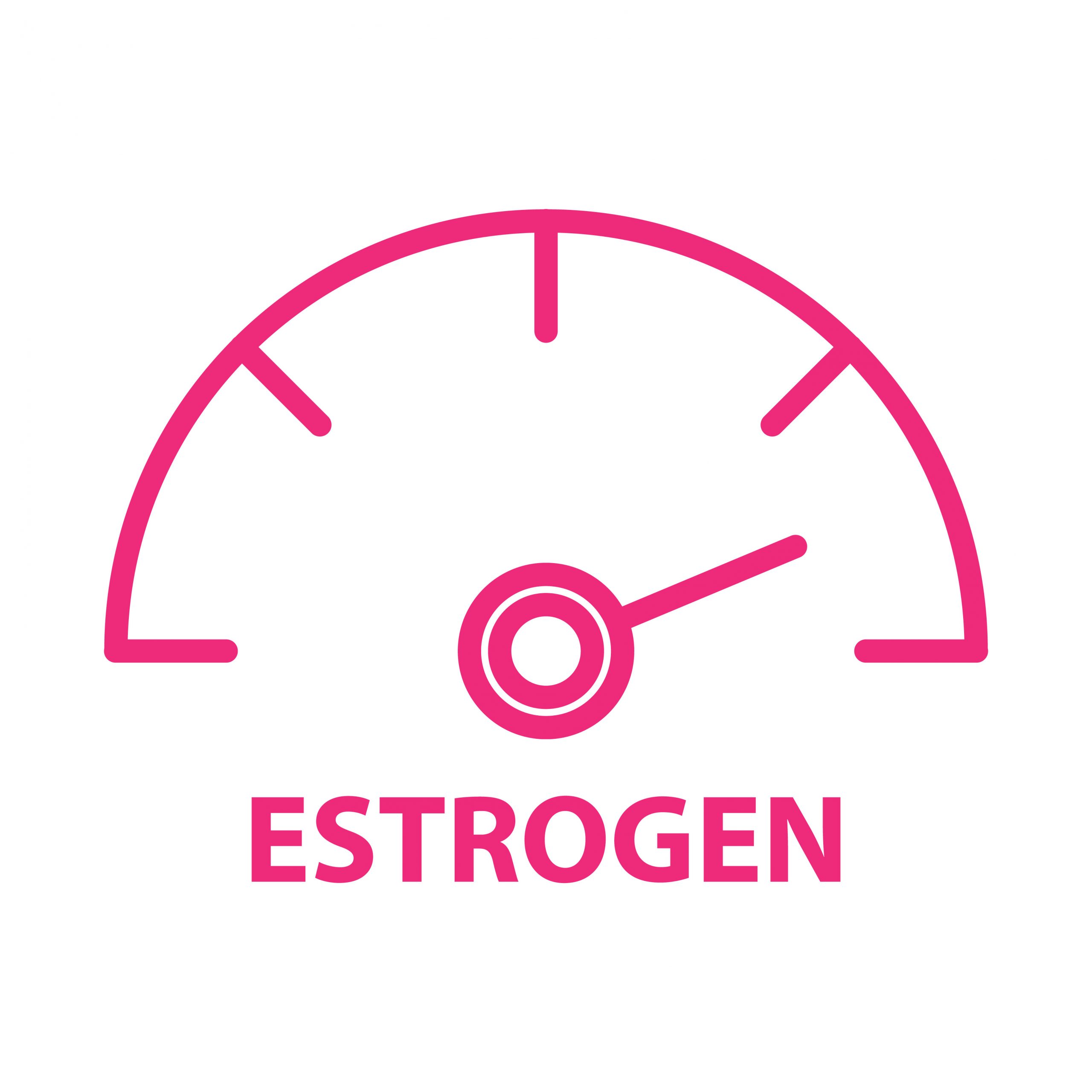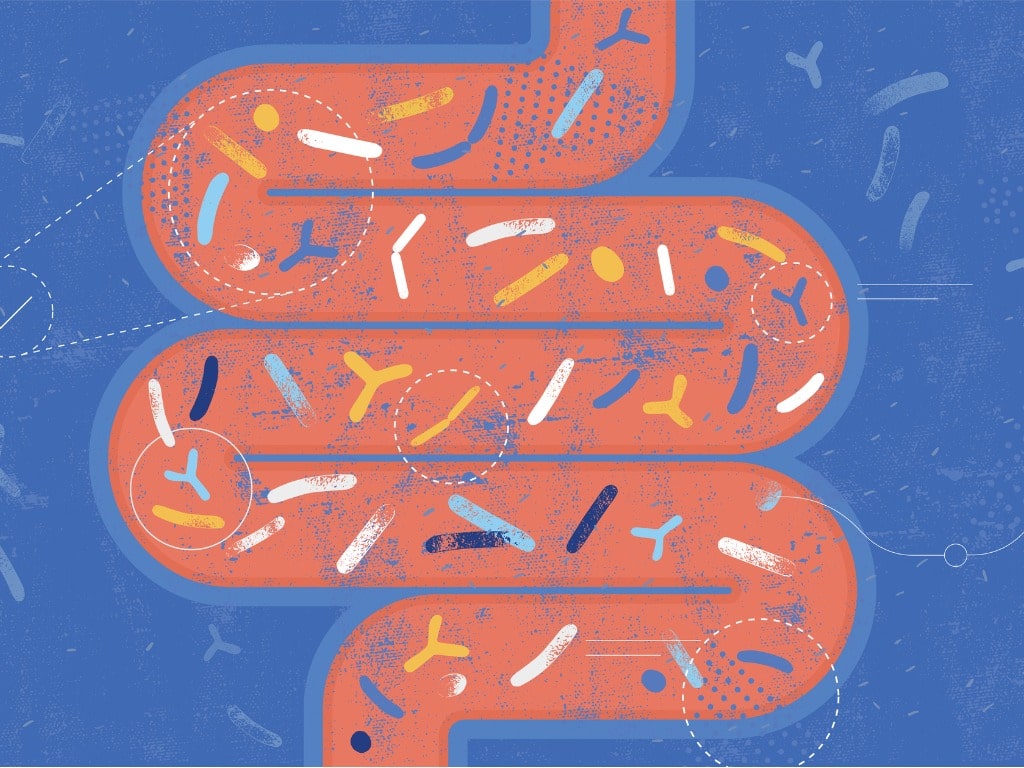Estrogen is produced by ovaries, adrenal glands, fat, and other tissues.
The body naturally detoxifies estrogen. The liver preps the estrogen in a form that’s easy to eliminate in the kidneys or with the help of bile in the feces.
Sometimes this process is hijacked by activity from the gut microbiome.
High production of beta-glucuronidase and beta-glucosidases from gut bacteria can reverse this process, allowing estrogens to be reabsorbed into the circulation where they can act on tissues again (1; 2; 3)
Estrogen dominance is when bad forms of estrogen are in higher ratios in women, and when testosterone to estrogen ratio is lowered in men. Estrogen dominance can lead to breast, ovary, and uterus problems in women, and prostate and breast issues in men (4; 5).
Estrogen is proliferative – meaning it promotes growth – excess exposure over a period of time can trigger cancer mechanisms in the body. It also interacts with chemicals and can make them more inflammatory and oxidative (6).
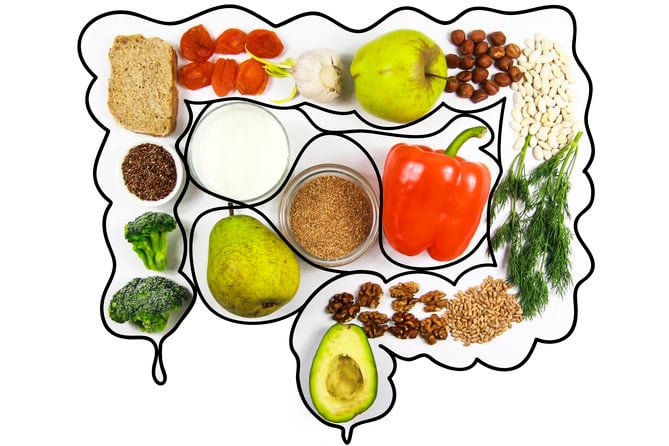
The gut microbiome is largely the most important factor for healthy estrogen metabolism and detoxification.
Microbiome diversity and balance will not only be a major determinant of estrogen metabolism but will also promote immune balance.
A balanced immune system is better able to scavenge for rogue cancer cells, protect from oxidative stress, determine the difference between a foreign invader and self, and manage inflammation.
Glucuronidation is an important pathway of estrogen detoxification – it converts estrogen to a form that’s deactivated and able to be released from the body. One can support this glucuronidation pathway using a supplement like calcium-d-glucarate.
Yet, high activity of beta-glucuronidase from gut bacteria can slow the body’s glucuronidation process in the liver – reversing the estrogen away from the form necessary for detoxification and “reactivating” it (7).
We can now identify bacteria that contain the genes for beta-glucuronidase activity with high accuracy. With stool testing, we can look at the presence and ratio of these bacteria in the context of the entire gut microbiome.
BiomeFx includes the “estrobolome” in its functional section.
The estrobolome refers to the total amount of estrogen-metabolizing genes and activity in the gut capable of producing high or low beta-glucuronidase activity (estrogen reactivation in the gut).
The estrobolome plays an important, functional (and controllable) role in maintaining normal testosterone and estrogen balance in men and women.
Other Factors in Estrogen Metabolism
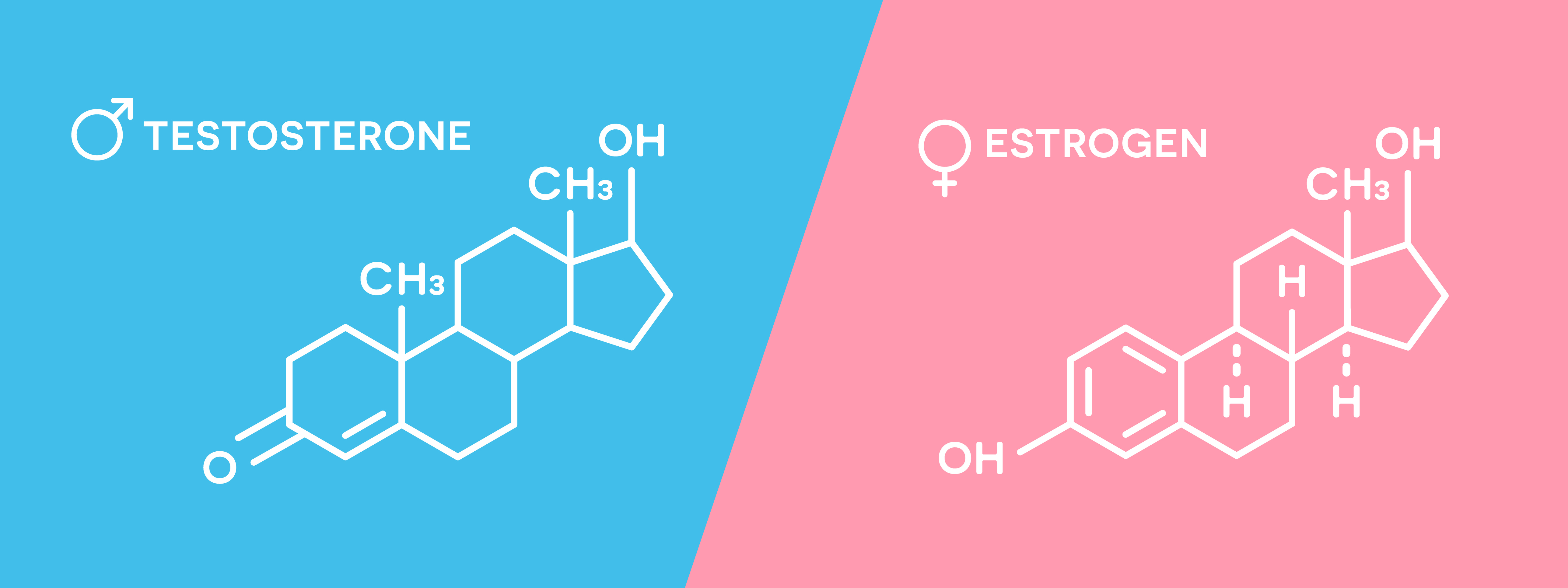
Constipation:
Constipation also increases the time that fecal matter interacts with microbial enzymes and will increase the reabsorption of free estrogens back into the circulation. The type of estrogen recycled is not preferred.
Maintaining gastrointestinal motility helps assure that estrogen is metabolized optimally as well. The health of the gut microbiome is often behind slow gut motility and is why regularity often improves when first starting probiotic therapy.
Check out our Top-to-Bottom Guide to Supporting Gut Motility for a full discussion.
Gallbladder and Bile Flow:
When estrogen is readied by the liver for detoxification. Bile acids in the intestines bind it up and carry it out through feces.
Gallbladder sludge is when the bile is thick and not flowing adequately – it can be a result of high stress, low stomach acid, high-fat diet, and high inflammation from a leaky gut. It can also be a result of fatty liver and high metabolic stress from overeating.
As a result of sludgy gallbladder activity, estrogen detoxification also becomes impaired – and unwanted estrogen metabolites re-enter the circulation where they can act on tissues again.
This is made worse when the microbial make-up of the gut has a high potential of producing enzymes that re-activate estrogen in the first place – aka the “estrobolome”.
This happens because digestive secretions are triggered by the relaxing, parasympathetic arm of our nervous systems – with stress, this function can be drowned out by the extra sympathetic activity.
Gut acidity also triggers bile readiness when food is ultimately released into the small intestine where bile is squeezed out of the gallbladder. A high-fat diet may simply overwork the gallbladder’s capacity to keep up with demand.
Lastly, inflammation affects the nervous system – directly injuring the vagus nerve or dialing down motility and gastric function at the level of the spinal cord due to the effects of endotoxins, disruptions in the blood-brain-barrier, and inflammatory cell messengers like TNF-alpha.
Immunoglobulins like those in MegaIgG2000 help to bind up and neutralize endotoxins.
You can support gallbladder activity with “cholagogue” herbs like milk thistle, as well as artichoke leaf and ginger like that found in MegaGuard.
Taking bitters prior to a meal will also jump-start digestive secretions including bile. I’ve been also using apple cider vinegar – diluting 1oz with water, or taking apple cider vinegar capsules prior to meals to help acidify the stomach and spur digestive function.
We use Better Bitters Orange to support digestion and motility. Peppermint is an antispasmodic that not only helps with constipation and SIBO, but can also support bile flow.
Curcumin is especially useful because it supports bile flow, liver detoxification, integrity of the gut and brain barriers, and is one of nature’s most recognized anti-inflammatory herbs. We use Theracurmin HP for its high bioavailability verified by 3rd party testing, as well as its high tolerance in clients compared to other forms of curcumin.
Lastly, you can supplement with bile acids directly using Ox Bile supplementation. This can be helpful but it is worth noting that dosage can be touchy – where too much bile acid supplementation can cause diarrhea. I use 150mg Ox Bile first, and move up to 500mg Ox Bile if warranted. If loose stools are triggered, back off on intake or discontinue.
Individuals who have had their gallbladder removed, still produce and release bile via their cystic duct – but it can be more apt to spasm and clogging – so it can be helpful to take some sort of bile support for the rest of your life after gallbladder removal.
There is an association with gluten and gallbladder issues as well – likely because the immune reaction to gluten is eight times more likely to affect the nervous system (including the nervous system of the gut) than it is to affect the intestines. Biliary problems can be caused by immune activity against the tissues as well.
So a gluten-free diet can be important in supporting normal gallbladder activity and bile release.
Xenoestrogens – Man-made Chemicals with Estrogenic Properties:
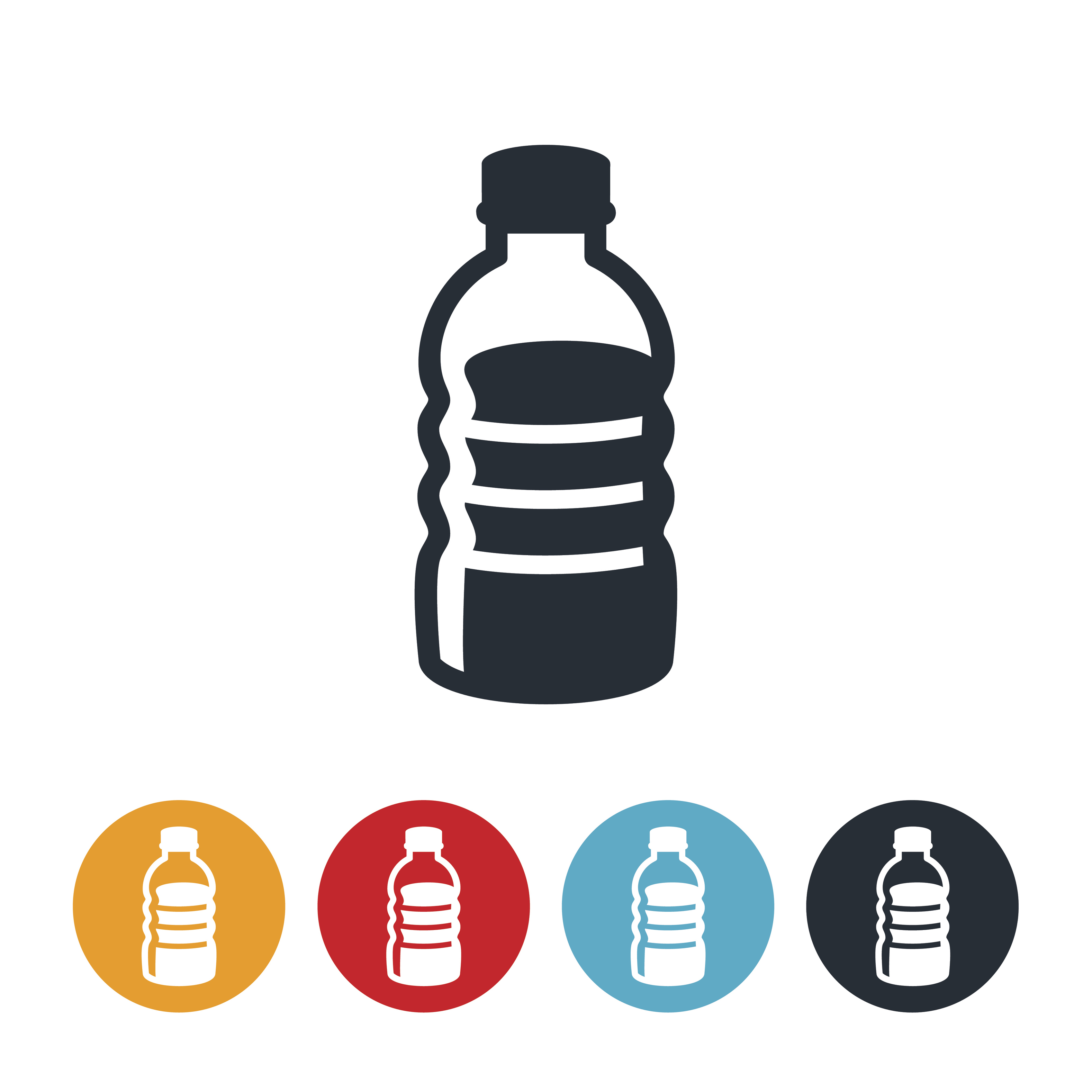 Some man-made chemicals may often have estrogenic properties – classifying them as xenoestrogens (Xeno pronounced “zen-o” means foreign or from the outside) – adding to the total estrogen burden on the body.
Some man-made chemicals may often have estrogenic properties – classifying them as xenoestrogens (Xeno pronounced “zen-o” means foreign or from the outside) – adding to the total estrogen burden on the body.
Because xenoestrogens are foreign to physiology – they can act stronger on the body, be tougher to detoxify, and take up more resources to insulate them from normal body activities.
One of the most notable xenoestrogens is bisphenol-A (BPA) – a man-made component of plastics that gives them rigidity that can leach into food and liquids.
It’s also a component of the ink used on store receipts – and routine handling of store receipts can add to the body burden of bisphenol A and its estrogen-like effects – putting cashier workers at heightened risk of high BPA exposure.
Plastic coffee lids are also an under-appreciated source of bisphenol exposure. The heat from the coffee creates condensation on the lid that falls back into the beverage.
Additionally, the acidity of coffee further leeches bisphenol A, creating a perfect storm of heat and acidity.
Most canned foods and beverages are lined with bisphenol A. Carbonated beverages such as soda or seltzer are more acidic in pH and can invite higher levels of bisphenol A.
Cans of tomatoes or tomato paste are often lined with bpa, and the acidity of the tomato further leeches BPA. Use glass bottles for storage or look for cans marked BPA-free.
If the environmental impact of plastic use wasn’t motivating enough – BPA exposure can be the extra push someone may need to stop using plastics.
Check out Bisphenol A Health Effects for a deeper discussion.
Other common sources of xenoestrogens include: cigarette smoke, car exhaust, forest fire smoke, fabric softeners, nail polish, perfumes, and non-stick cooking pans.
Genetics:
Genetics rarely determine destiny – instead, they most commonly determine our metabolic tendencies.
Genetics load the gun, it’s diet, environment, and lifestyle that fire the trigger. Despite having higher risks for estrogen dominance – it is still possible to support normal estrogen metabolism with diet, exercise, and supplements when appropriate.
If breast cancer, uterine cancer, ovarian cancer, polycystic ovarian disease, prostate hypertrophy or prostate cancer run in your family, it can be helpful to optimize the bacteria in the gut to reduce reactivation of estrogens.
BRCA1 and BRCA2 are the most well-recognized genes involved in estrogen metabolism. These genes are associated with slow estrogen metabolism and altered ratios of “good” and “bad” estrogens.
What are good and bad estrogens? Not all estrogen is made equally – it comes in different forms that have different effects on the body. Good estrogen is known as 2-hydroxestrone (E2). And, bad estrogen is known by the variations 16-alphy-ydroxy-estrone (E-16) or 4-hydroxyestrone (E4).
Often when we speak of estrogen dominance, there’s a higher ratio of E16 and E4 estrogen versus the preferred E2 form.
When we talk about estrogen deficiency – sometimes total estrogen will be normal, but the ratio of good to bad estrogen may be deficient and enough to cause deficiency-related symptoms.
Estrogen excess, especially when dominated by “bad” forms, can be associated over time with higher risks of breast, uterine, and ovarian cancer in women (and potential issues in men too).
As the breast, uterus, and ovaries are sites of high cell activity and monthly turnover, they are more sensitive to chronic elevations of estrogen.
In men, the prostate is slower growing, so is less sensitive until older age, and prostate cancers tend to be slower growing and other causes of health problems may take more precedence in the age group.
Nevertheless, aggressive prostate cancer is nothing to take lightly. And, most notably, testosterone levels in men have been declining steadily and are a fraction of the levels maintained by our grandfathers.
Both men and women can control their risk decades prior by paying attention to sources of estrogen excess from an high-insulin, high-carbohydrate diet, worsened by high intakes of soy and alcohol. Beer for instance has estrogenic compounds of wheat, carbohydrates, and alcohol.
High intake of beer and processed food (high soy) in a man can be associated with higher estrogen ratios – reducing testosterone production, and contributing to low sperm count, erectile dysfunction, the development of breasts (“man-boobs”) and the prototypical “beer belly” – which leads to more estrogen conversion.
The same dietary influences acting in women may be associated with the development of facial hair, male-pattern hair thinning and baldness, vaginal dryness, and disordered menstrual cycles including heavy or scant bleeding, or amenorrhea (loss of period) altogether.
It’s worth noting that the higher fat, especially around the belly, is a huge source of inflammation as fat tissue releases inflammatory compounds as a natural consequence of its metabolic activity.
This worsens hormone imbalances and also contributes to fatigue, muscle and joint pain, constipation, and risks of non-estrogen related cancers.
Women at higher risk may want to be mindful of low-dose estrogen in birth control, hormone replacement, and low-dose bio-identical hormone therapy. One of the books that I recommend that is ordered the most is The Pill Problem by pharmacist Ross Pelton, who explores some of these risks.
I’ve discussed the nutritional deficiencies associated with oral contraceptives too with one of the most quietly popular articles on my site: The Importance of Supplementing Vitamins and Minerals While on Oral Contraceptives
A low dose or “bioidentical” form of hormones may not seem problematic at first glance and there are times when they can be medically necessary, but when you juxtapose it with potential genetic and microbiome tendencies (the estrobolome), diet, lifestyle, stress, environmental exposures, and simply a longer duration of taking an outside estrogen (ex/ 10-30 potential years of oral contraceptive therapy), the sources of exposures add up.
Each decision is highly personal and my bias is toward natural options to coax and maintain the balance in the first place.
Maintaining healthy blood sugar and normal stress levels while optimizing the gut microbiome will arguably provide the most bangs for the buck when it comes to long-term balance of hormones in men and women.
The estrobolome is just one of many functional criteria covered in BiomeFx stool testing. This new microbiome analysis gives an enormous amount of personal and actionable information that can be used alongside organic acid testing, and traditional blood markers.
Blood sugar spikes will lead to spikes in hormones that alter proper balance, and the body’s production of the stress hormone cortisol will “steal” production away from sex hormones.
Natural Ways for Men and Women to Improve Estrogen Metabolism and the Estrobolome:
 Whether one’s predilection to estrogen imbalances is genetic or functional, there are a number of natural ways to improve estrogen metabolism.
Whether one’s predilection to estrogen imbalances is genetic or functional, there are a number of natural ways to improve estrogen metabolism.
Microbiome Health:
Microbiome diversity is the number one way to help the estrobolome as high diversity will crowd out the estrogen reactivating properties of some bacteria.
I’ve explored a number of ways to increse microbiome diversity – starting with Megasporebiotic as the hub, and spoking out into other probiotic strains and prebiotic fibers.
See Dr Rinehart’s Probiotic Blueprint for a deeper discussion. See exactly how well your microbiome is doing, including an estrobolome section with BiomeFx.
Here’s a sneak peak at what that section of the report looks like:
Lifestyle Stress:
Stress steals from normal production of testosterone and estrogen – creating imbalances.
Stress can come from emotional, physical, chemical or food triggers. If you over-exercise without adequate recovery, or if you continue to eat foods you’re sensitive to like gluten, dairy, and others – these can be sources of adrenal fatigue.
Drinking coffee or other caffeine sources daily without ever giving your system 10-14 day breaks periodically will also steal your body’s ability to handle stress normally – and will work to make fatigue more of your default state (making you crave more coffee and sweets).
When stressed, restorative sleep is often disrupted – continuing the cycle of hormone imbalances day after day.
As a result your sex hormone production can become out of balance and tilt to higher levels of testosterone and bad estrogen in women – and less testosterone and higher estrogen in men.
If this is a major problem for you, take a look at 10 Powerful Strategies to Get to the Root of Stress-Related Symptoms and get to the root causes of stress and resulting hormonal imbalances.
Diet:
Sugar is problematic for a number of reasons.
First, high spikes of sugar may not lead to high fasting blood sugar in the short-term- but it does put a strain on your stress system to respond and keep your sugar stable in the first place – so sugar fluctuations are a vastly overlooked source of adrenal stress.
Second, excess sugar is converted to fat – and fat contains the enzyme aromatase. Aromatase turns testosterone into estrogen – leading to estrogen dominance in men and women.
Third, spikes in insulin from sugar intake create surges in testosterone-related compounds known as androgens. This is in part why high sugar can lead to adult acne as one example, and why poor sugar regulation is associated with polycystic ovarian syndrome and more moderate-to-severe premenstrual symptoms as other examples.
Check out Herbal Medicine for Diabetes and Stress Relief for more complete discussion on blood sugar support.
Phytoestrogens:
Certain foods contain estrogen-mimicking chemicals. These can act as a double-edge sword. One one hand phytoestrogens tend to be weak, so if they’re competing with other estrogens, they can help lower the total estrogen activity by crowding out the activity of stronger estrogenic compounds like xenoestrogens.
Excess phytoestrogens from food can still add to estrogenic activity – and so when estrogen is high in the blood, and if the estrobolome is high in the gut (as can now be determined by BiomeFx testing), it can be beneficial to remove and limit intake of soy (tofu, tempeh, miso, soymilk) and alcohol.
Other foods can have estrogenic qualities but soy and alcohol are the biggest culprits because of their prevalence in a standard American diet high in processed food – and a culture where drinking is a welcome context of many social events.
Some foods and spices can help spur estrogen metabolism – specifically cruciferous vegetables (cabbage, bok choy, broccoli, cauliflower and others), as well as turmeric.
Foods and spices that help regulate blood sugar and inflammation can also be helpful – think of fennel, cinnamon, garlic, ginger, and foods lower on the glycemic index scale – a measure of how fast sugar is released from food.
Supplements:
 Probiotic and prebiotic support such as Megasporebiotic and Megaprebiotic:
Probiotic and prebiotic support such as Megasporebiotic and Megaprebiotic:
These increase and help maintain microbial diversity and have been shown to work in synergy to boost microbiome diversity.
For everything you need to know about Megasporebiotic, check out our Megaspore Resource Page
Calcium-D-Glucarate:
Calcium-D-glucarate provides the raw materials necessary for the glucuronidation detoxification pathway of estrogen to occur in the first place.
This is the same pathway that a hyperactive estrobolome will reverse – yet calcium-d-glucarate can help favor detoxification and maximize estrogen metabolism and help hold the pedal down on the detoxification pathway in the first place.
I use Calcium-D-glucarate by integrative Therapeutics.
Diindolylmethane (DIM):
DIM is a regular constituent of hormone-balancing formulas for good reason. It is an active ingredient from cruciferous vegetables (such as cabbage, cauliflower, and broccoli) that helps to detoxify bad estrogens favorably over good estrogen – while also blocking aromatase – the enzyme found especially in belly fat that converts testosterone into estrogen. This means that it is helpful for both men and women looking to balance estrogen levels.
DIM Detox is probably our popular combination of DIM and liver-supportive ingredients. DIM can also be supplemented on its own, such as BioDIM by Klaire Labs, or Nanoemulsified DIM by Quicksilver Scientific.
Sulforaphane:
Sulforaphane is another active compound found in broccoli and cruciferous vegetables that helps with estrogen detoxification (8). It is also well-regarded to turn on anti-aging genes such as NRF2. I use SulforaXym by Master Supplements/US Enzymes.
Blood Sugar Herbs, Extracts, and Nutrients:
Many fit in this category – yet I like gymnema, bitter melon, cinnamon, berberine, and resveratrol. Chromium supplementation is popular too, and Chromemate GTF is a popular form.
Additionally, magnesium plays essential roles in blood sugar regulation, inflammation, hormone metabolism, and relaxation. It is involved in over 300 reactions of the human body, and depleted rapidly when someone is in a stressed state. I use magnesium glycinate most regularly as the glycine residue of that form promotes calmness and detoxification in its own right.
One of my favorite and cost-effective combination formulas is Mycobotanicals Blood Sugar by Host Defense Mushrooms that combines gymnema, cinnamon, bilberry (also known for supporting eyesight), and the widely-supportive medicinal mushrooms Maitake, Reishi, and Chaga which are popular as individual supplements too.
GlucoFunction by Pure Encapsulations combines a slightly different array of blood sugar-supportive ingredients, this time including bitter melon, chromium, and vanadium too.
Adrenal Support Herbs, Extracts, and Nutrients –
Again, many options fit in this category. Some of my favorites are ashwagandha, rhodiola, holy basil, L-theanine, magnolia bark, magnesium, phosphatidylserine, PEA, and phosphatidylcholine.
You’ll find popular combinations in products like HPA Adapt, Cortisol Manager (an industry-leader), ProSOM Sleep, or Adaptocrine.
While you’ll find the above options more affordable, Neurohacker Collective is an up and coming brand making some fantastic adaptogenic, and focus-boosting formulas.
I like Qualia Mind Caffeine Free personally as it is arguably the most comprehensive adaptogenic formula available at the time of this writing. The capsules have a strong herbal odor that may not be tolerated by some – yet it’s a tribute to its potency.
The more serious biohackers among us are used to taking some odd-smelling or odd-tasting formulas and not thinking twice.
Did you know, for instance, the name Ashwagandha is rooted in the Sanskrit word for “Sweaty Horse”? – a tribute to the hormone-balancing energy and vigor it can provide, but also for its distinctive smell. It’s found in a few of the formulas mentioned above.
Melatonin could be in this category too for its well-known role in promoting sleep
Melatonin also promotes anti-inflammatory properties especially targeted to brain health. Use 0.3mg for more day-to-day use (ideally 6 hours prior to intended bed-time), and up to 3mg for more serious jet lag and support of more complex health issues.
Melatonin has been regarded for support of breast health (9). More recently, it has been mentioned as an anti-inflammatory and antioxidant adjunct in the context of viral infections that may disrupt restorative sleep and also increase inflammation in the central nervous system (10).
Follow guidance from a natural health professional when dosing melatonin in the 3-9mg+ range or with the intent of supporting more complex medical problems.
Maintain Oral Health:
Microbial health, especially in women, is affected considerably by fluctuations in estrogen levels.
The gut, oral, and vaginal microbiomes are all affected by estrogen imbalances – and it’s one of the reasons suggested for why women have a much higher incidence of autoimmune diseases than men (11; 12). Women prone to yeast infections or with a history of bacterial vaginosis may have a history of low “good” estrogen (13; 14).
One of the best ways for women to maintain health and diversity of all “biomes” in the body is to optimize estrogen ratios using some of the strategies mentioned throughout this article.
Yet, the relationships are two-way streets – meaning that support of the microbiome in the mouth can help support the gut and hormonal health because of influences of lower inflammation and unwanted gut seeding with pathogenic or opportunistic microbes from the nose and mouth.
Oral health is a huge source of inflammation in the body as all bacteria and potential pathogens from the nose and mouth can be swallowed directly into the gut – and if not deactivated by adequate stomach acid, can create inflammation and alter the gut microbiome such as seen in dysbiosis and SIBO.
You can use a microbial balancing toothpaste like DentalCidin, a rinse like Dentalcidin LS Liposomal Oral Care, or a throat spray like Biocidin Throat Spray or Megacidin (Biocidin + spore probiotics).
Brushing and flossing are staples (ideally following all meals), tongue and cheek scraping, and other habits like changing your toothbrush often as it can be a storehouse of bacterial biofilms.
Support Gallbladder Function and Bile Flow:
MegaGuard, Milk Thistle, Ox Bile, and other “Cholagogue” (promote gallbladder function) herbs.
Berberine-containing herbs like barberry and goldenseal like those in Berberine Complex also promote bile function in addition to supporting normal levels of gut flora.
Taking digestive bitters, diluted in a little bit of water, can also help prime the flow of bile and digestive juices. Adding citrus zest, or lemon juice to foods and beverages helps the same.
Eating bitter foods such as carrot greens, turnip greens, mustard greens, escarole, or broccoli rabe help to do the same.
Just thinking of some of these bitter foods may have your mouth salivating – which should give some immediate insight to the effects they are having on the rest of the digestive system.
Environmental Exposures:
Much of the issue with estrogen dominance comes from exposure to estrogenic chemicals in our environment.
Watch use of plastics, use glass containers, and cover foods with parchment paper with rubber bands instead of cellophane plastic wrap, avoid BPA-lined canned foods especially tomato products, take the plastic lid off of your coffee, use paper and metal straws over plastic.
Many of these chemicals are found in the air too such as flame retardants in furniture, off-gassing from plastics in electronic devices, and car exhaust that makes it into the home.
Use air filters in the home – especially those that trap Volatile Organic Compounds (VOCs) such as EnviroKlenz which uses VOC-neutralizing/binding earth metals or the Dyson Pure Cool air filter that contain the added ring of activated charcoal in its HEPA filter.
If you live in areas prone to forest fire smoke – it’s yet another reason to invest in an air-purifying unit.
Each day, new untested chemicals are used in products and industrial processes and released into our air, or dumped (or leeched) into the water supply or and go unfiltered in water treatment facilities. Government agencies take the approach that many of these chemicals are safe until proven otherwise – making us all guinea pigs for not just the individual chemicals, but also the additive interactions with one another.
Cosmetic Safety:
Pay attention to the chemicals, additives, fillers, and potentially estrogenic agents in cosmetic products.
Anything you put on your skin will be absorbed into the bloodstream – so if you wouldn’t feel safe potentially eating or drinking a product, why are you putting it on your skin?
Use the Environmental Working Group (EWG) cosmetics database to cross-check the chemicals on your product labels.
Eat organic as pesticides and herbicides not only have estrogenic aspects – but are obesogenic (fat-causing) which is another source of internal estrogen creation. At the very least focus on the dirty dozen fruits and vegetables also published by the EWG.
Not everyone can live off-the-grid – and even then can still be subject to air and water issues, not to mention forest fire smoke.
Control what you can naturally and use supplements to give an added edge to detoxification support as the world is now sadly full of unavoidable exposures.
Estrogen Testing:
Arm yourself with information, look into testing with your functional health doctor such as Spectracell’s Female and Male Hormone Health profiles, or estrogen metabolism testing to look at the balance of estrogen metabolites and draw personalized conclusions.
While your doctor may not carry certain labs, they may be able to order specific markers a la carte’ for you.
Test your microbiome accurately with BiomeFx to see how healthy and diverse it is – and how to optimize the Estrobolome.
As the test looks at function, and not diagnosis, it can be purchased without a prescription or doctor order and performed in the privacy of your home.
Learn all the other ways personalized microbiome analysis can be useful.
Related Content:

